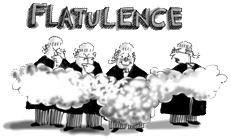Finkelstein or Frankenstein Report?
 Theodora •
Theodora •  Thursday, March 8, 2012
Thursday, March 8, 2012 Is the Finkelstein Report as dangerous as the media imagines? ... A properly run News Media Council could keep journalists' dark arts in-check ... Only an arrogent media would reject the Fink's recommendations out-of-hand
 Fink: comprehensive and worthwhile recommendationsJudging by mainstream newspaper reaction, Ray Finkelstein and Professor Matthew Ricketson are proposing a government funded monster to regulate every corner of Australia’s media.
Fink: comprehensive and worthwhile recommendationsJudging by mainstream newspaper reaction, Ray Finkelstein and Professor Matthew Ricketson are proposing a government funded monster to regulate every corner of Australia’s media.
Even in the news pages the reporting underscored some of the very concerns Finkelstein was on about.
The Australian Financial Review, page one (March 3): Labor plan to control the media.
The Sydney Morning Herald (March 3): Fears of media showdown if new watchdog wins approval, followed by “analysis” headlined: Over-regulation worry.
The Australian (March 3) declared: Fears for freedom as watchdog unleashed.
Finkelstein’s proposal for a government funded News Media Council, a statutory body to set journalistic standards and handle complaints, won’t be considered by the government until after the convergence report is released later this month.
The idea is that the NMC will cover not only newspapers, but news, current affairs and commentary published on radio, television and online.
It will replace the Australian Press Council, the voluntary, self-regulatory press standards body, and the Australian Communications and Media Authority’s conduct and standards functions – such as they are – for radio and television.
As Finkelstein says:
“In an era of media convergence, the mandate of regulatory agencies should be defined by function rather than by medium.”
The new body should have the power to require media outlets to publish apologies, corrections, retractions and afford rights of reply.
A speedy conciliation process is envisaged, where matters are dispatched within two or three days. If arbitration is required, resolution should be achieved in weeks, not months.
All of this for an optimistic $2 million a year.
Finkelstein says this sort of redress for breaches of ethical standards is in line with existing codes of practice, but often difficult to obtain.
Indeed, media organisations that enthusiastically endorsed the NMC model might position themselves as running “gold standard” accountable operations, in tune with their readers, viewers or listeners and building confidence in their accuracy and fairness.
 Dark artist at workAs it is, many journalistic practices are allowed to run riot. Apart from the usual slew of vitriolic attacks and breaches of privacy there are other insidious practices that go untrammeled.
Dark artist at workAs it is, many journalistic practices are allowed to run riot. Apart from the usual slew of vitriolic attacks and breaches of privacy there are other insidious practices that go untrammeled.
These darker arts are not discussed in the report, but nonetheless are in full swing, including.
• The sources of some specialist roundsmen are warned not to speak to the competition, otherwise they’ll be “punished”, either by being frozen out editorially or directly attacked (usually in print).
• People approached for information who are uncooperative are threatened with adverse publicity.
• Misquoting or out of context reporting is more widespread than commonly realised.
• So too “blagging” (reporters pretending to be someone else in order to extract information).
• Commercial interests and personal friendships are not sufficiently disclosed, even by some opinion writers in quality broadsheets.
• The use of private detectives by the media, particularly in litigation, goes beyond what is acceptable. There are instances where plaintiffs have had their homes burgled and computers stolen or otherwise attempted to be compromised in ways that could be used against their court cases.
• The use of the “bogus balance technique” where one-sided crusades are launched in the news pages of a newspaper while occasionally more moderate reports are to be found in the opinion pages or largely unread editorials. The paper then argues with a straight face that its reporting has encompassed a variety of views and has been “balanced”. This is the way in which The Australian covered the government’s climate change policies.
These things are all part and parcel of the reporter’s armory, despite various worthy codes of conduct.
These too were the relatively small fry dishonesties that characterised the British newspaper business and were the precursors to phone, computer and email hacking and the widespread compromising of public officials.
The upshot is that venerable institutions of British life were corrupted by certainly one, maybe more, media organisations: Whitehall politicians, the police, the civil service and the media itself.
 Murdoch: contagionA decently funded watchdog on journalistic practices would go a good way to ensuring the English contagion does not spread here.
Murdoch: contagionA decently funded watchdog on journalistic practices would go a good way to ensuring the English contagion does not spread here.
Actually, the scandal surrounding the Murdoch press in Britain which gave birth to Lord Justice Leveson’s inquiry into the media is producing some interesting thinking.
Hugh Tomlinson QC from Matrix Chambers and the Reuters Institute for the Study of Journalism have put together a team lawyers, academics, journalists and others.
They have come up with a proposed Media Standards Authority whose governing council would be composed of a minority of former editors and some working journalists.
Importantly, media participation in the authority would be voluntary, but there are some interesting sticks and carrots, including an adjudication scheme that complainants would be required to use before going to court and enhanced defences in legal proceedings for participants.
Sanctions would be part of the “membership contract”. The MSA would also offer pre-publication advice and assistance in privacy cases.
In other words, a voluntary regime with a mechanism to have defamation, privacy as well as more minor complaints all resolved outside the courtroom.
Finkelstein is recommending a self-regulatory regime at the threshhold level with enforced membership.
Findings and orders by the News Media Council would not be subject to merits review or an internal appeals process, but would be subject to judicial review and court enforced compliance with a NMC determination.
Australia has been down the media review path before, with a singular lack of results.
As a result the APC continued to be a press-patsy more or less until Julian Disney took over the chair in 2009.
There needs to be further thinking on a number of issues, importantly the scale of internet news operations or bloggers that would be subject to the compliance.
Of course, the NMC will only work if the right people end-up being appointed. However, Finkelstein and Ricketson have put forward some worthwhile proposals that only an arrogant media would reject out of hand.
What has been going on in Britain is a brutal reminder of what happened when the media clung to the institutionally conflicted voluntary model of “accountability”.
This article first appeared in the Gazette of Law & Journalism.
Other commentary about the Finkelstein Report:









Reader Comments